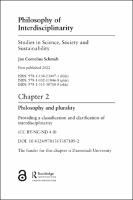Chapter 2 Philosophy and plurality
Proposal review
Providing a classification and clarification of interdisciplinarity
| dc.contributor.author | Schmidt, Jan Cornelius | |
| dc.date.accessioned | 2022-03-02T11:21:01Z | |
| dc.date.available | 2022-03-02T11:21:01Z | |
| dc.date.issued | 2021 | |
| dc.identifier.uri | https://library.oapen.org/handle/20.500.12657/53176 | |
| dc.description.abstract | What exactly do—and should—the terms “interdisciplinarity” and its cognate “transdisciplinarity” mean? This chapter exposes different understandings of inter- and transdisciplinarity and sets out a foundation for a critique of innumerable usages of these hype terms. It starts by presenting a plurality of motives behind these notions, followed by criteria characterizing the semantic core of the notions, namely (i) the existence of (disciplinary or academic) boundaries and (ii) the transgression or overcoming of those boundaries. Based on the dialectic consideration of boundaries and with reference to well-established distinctions in the philosophy of science, a plurality of four types is shown: interdisciplinarity with regard to (a) objects, (b) knowledge/theories concepts, (c) methods/practices, and further, (d) problems/issues. Different philosophical thought traditions can be related to the four types. All four types can be illustrated by research programs that are labeled “interdisciplinary”: nanoresearch, complex systems theory/chaos theory, biomimicry/bionics, and technology assessment/sustainability research. In this chapter special emphasis is given to the complex relation between interdisciplinarity and transdisciplinarity. Arguments favoring a critical-reflexive concept of problem-oriented interdisciplinarity going beyond what is typically associated with transdisciplinarity are presented. This terminological clarification constitutes the very basis for the Philosophy of Interdisciplinarity set forth in this book. | en_US |
| dc.language | English | en_US |
| dc.subject.classification | thema EDItEUR::P Mathematics and Science::PD Science: general issues::PDR Impact of science and technology on society | en_US |
| dc.subject.other | History of Science; History of Technology; Philosophy of Technology; Scientific Ethics; Synthetic Biology | en_US |
| dc.title | Chapter 2 Philosophy and plurality | en_US |
| dc.title.alternative | Providing a classification and clarification of interdisciplinarity | en_US |
| dc.type | chapter | |
| oapen.identifier.doi | 10.4324/9781315387109-2 | en_US |
| oapen.relation.isPublishedBy | 7b3c7b10-5b1e-40b3-860e-c6dd5197f0bb | en_US |
| oapen.relation.isPartOfBook | cc8609ba-efd4-4fdf-b145-eb87a6434c9c | en_US |
| oapen.relation.isbn | 9781138230071 | en_US |
| oapen.relation.isbn | 9781032118468 | en_US |
| oapen.imprint | Routledge | en_US |
| oapen.pages | 26 | en_US |
| oapen.remark.public | Funder name: Darmstadt University | |
| peerreview.anonymity | Single-anonymised | |
| peerreview.id | bc80075c-96cc-4740-a9f3-a234bc2598f1 | |
| peerreview.open.review | No | |
| peerreview.publish.responsibility | Publisher | |
| peerreview.review.stage | Pre-publication | |
| peerreview.review.type | Proposal | |
| peerreview.reviewer.type | Internal editor | |
| peerreview.reviewer.type | External peer reviewer | |
| peerreview.title | Proposal review | |
| oapen.review.comments | Taylor & Francis open access titles are reviewed as a minimum at proposal stage by at least two external peer reviewers and an internal editor (additional reviews may be sought and additional content reviewed as required). |

